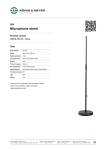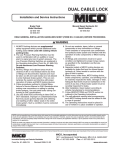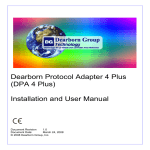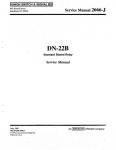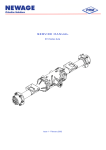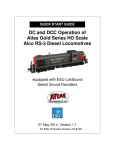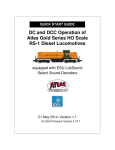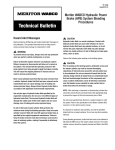Download Clutch Servos - wabco india limited
Transcript
Clutch Servo – Service Manual 1.0 Introduction Clutch Servos are used to reduce the force required to operate the clutch pedal and to permit sensitive and accurate actuation of the clutch in the vehicle. Refer Fig.1. Two sizes are produced by WABCO – 3 inch and 4 inch. The size refers to the diameter of the pneumatic section of the clutch servo. Fig.1 2.0 Design The Clutch servo consists of three parts: - Hydraulic slave cylinder - Control Valve - Pneumatic Servo cylinder Some of the other optional accessories available with clutch servo are - Electrical trigger through a electrical sensor to activate transmission control - Mechanical wear indicator Page 1 3.0 Operation The clutch servo has two ports, one for oil inlet and other for air inlet. Oil inlet port connects with the Master Cylinder operated by clutch pedal. The air inlet port takes air from the auxiliary reservoir connected to port no.24 of system protection valve. Refer fig.2 for details. a) At Rest Position: (Refer Fig.3) During this position, air from reservoir enters the air inlet port and will be acting around the inlet valve. There is no oil pressure in the oil inlet port of the clutch servo. The push rod will not travel and generate any force. b) Working position : (Refer fig.4) During working position the driver depresses the clutch pedal. The pressurized oil from Master Cylinder enters the hydraulic chamber and applies force on the hydraulic rod, which in turn provides force output in the push rod. Pneumatic assistance : The hydraulic pressure acting inside the chamber will also push the PIN & PISTON of the control valve closing the exhaust opening and opening the air passage by pushing down the air inlet valve. Air from the inlet port now flows through the cross hole to the pneumatic chamber acts on the piston providing assistance. Pneumatic and Hydraulic pressure acting on the push rod together will disengage the clutch. The air pressure in the chamber below the piston balances the hydraulic pressure acting on the Pin. c) Release stroke: (Refer fig.5) When the driver releases the clutch pedal oil from hydraulic chamber returns back to master cylinder. The hydraulic pressure reduces and the pin moves up. This will make the inlet valve to return back to the original position by return spring closing the air inlet passage. Further movement of the pin to the topside will make the exhaust passage to open. Air from the pneumatic chamber is vented through the exhaust retracting the push rod. This will cause the clutch to engage. The air circulation to chamber “A” will be through the duct, which is connected to atmosphere through the exhaust valve. The chamber in “B” remains proportional to the hydraulic pressure at all times thus giving the driver full control when engaging back the clutch. In case if there is no air available in the reservoir or the pressure falls down to lower value it is still possible to operate the clutch only with the hydraulic pressure. However this requires a greater force to be applied by the driver. 4.0 Wear Indicator: All the clutch servos supplied to AL are provided with Wear Indicator as shown in figure 1. The purpose of wear indicator is to show the amount of wear taking place in the clutch. Method of adjusting wear indicator is given Annexure 1. Page 2 5.0 Installation Requirements: The clutch servo should always be installed in horizontal position with the exhaust facing downwards. The bleeding screw should always be positioned in such a way that it should facilitate easier bleeding during installation. While assembling the Fork to the push rod of clutch servo ensure the stand out is maintained as per recommendations given by the OEM. While servicing and reassembly in the vehicle bleeding should be done properly for proper functioning of clutch servo. It is recommended to carry out pressurized bleeding through the bleed screw of the clutch servo since this ensures proper bleeding and saves time. In case manual bleeding is done please follow the procedure given below: Manual bleeding of Clutch Servo: 1. Top off clutch master cylinder reservoir and fill adequate amount of fluid. 2.Put a transparent Plastic tube or hose on the clutch servo bleeding nipple and submerge the other end of tube in a jar with some hydraulic fluid 3. Slowly depress the clutch pedal 4. Slightly loosen the nipple 5. While fluid is traveling through the plastic tube, tighten the bleeder before the pedal is fully released 6.Release the pedal Repeat the procedure until: - No bubbles appear in the fluid section - The bleeder nipple was opened after the clutch pedal started depressing and was closed before the pedal reached the bottom. Mounting : Using M8 Screws and nut with lock washer Fork – Assembled with Lock nut Hydraulic piping: Air pipes – Min 6mm Inner diameter Hydraulic pipe – Min 5mm Inner diameter for length upto 4m Min 6mm Inner diameter for length exceeding 4m Avoid routing the hydraulic pipes without any high points in between which may result in air trap as shown below. NO Master cylinder Clutch servo YES Recommended Hydraulic fluid : Brake Fluid to SAE J1703 Page 3 6.0 Servicing of Clutch Servo: No special maintenance is required for Clutch Servo in the field except for the following points: 1. Check during routine vehicle maintenance for any leak in the joints – both air and hydraulic. 2. Check for tightness of mounting bolts, Fork and bleeding screw 3. Clean the wear indicator and exhaust valve in case if it is soiled 4. Overhaul the unit using appropriate repair kit once in 3 years through SCL’s Authorised Service Centre. 7.0 Repair kit details: Recommended Repair kit for 3 inch Clutch Servo to part no. 9700514290, 9700514300 and 9700514350 contains the parts as shown in the exploded view given below in page 5. Repair Kit – BOM Ref. No.(#) Description Qty 25. 23. 19. 20. 21. 43. 41. 44. 45. 47. 3. 5. 9. 8. 10. 11. 12 / 13 16(17) 29. 31. 32. 38. 33 35. 37. “A” 1 no 1 no 1 no 1 no 1 no 1 no 1 no 1 no 1 no 1 no 1 no 1 no 1 no 1 no 1 no 1 no 1 no each 1 no 1 no 1 no 1 no 1 no 1 no 1 no 1 no 1 no Protection plug for bleeder screw “O” Ring “U” Ring – Hydraulic “O”Ring Guide Retaining washer (Wear Indicator) Spring – Wear Indicator “O”Ring – Wear Indicator “O”Ring – Wear Indicator - Rod Filter – Air inlet “U” Ring – Pin “O”Ring – Piston “U”Ring – Cartridge Outlet “U”Ring – Cartridge Inlet Inlet Valve “U”Ring – Inlet valve Spring – Inlet Valve Exhaust protector assembly Spring – Piston “U”Ring – Piston Hanger – Piston Front plate “O”Ring Retaining Ring – Push rod Sealing Ring – Front plate Grease Sachet “#” – Reference no. as shown in exploded view Page 4 Parts that are shown as “ “ forms part of Repair Kit Issue no.1 – Jan 07 Page 5 Fig.2 Port Details Pneumatic section Control Valve 11 – Air Inlet port 1-4 – Oil Inlet • Electrical Sensor - Optional nSS nSS Fig.3 • AT REST Position • Air Pressure only available in the port • No Force in the push rod • Clutch is Engaged Air pressure around Inlet Valve nSS nSS Fig.4 • Working Position • Air & Oil Pressure available in the port • Force in the push rod • Clutch is Dis-Engaged • Driver depresses the clutch pedal. Oil volume goes to hydraulic chamber of clutch servo through oil port Piston Pin Hydraulic chamber nSS nSS Fig.5 • Release Position • Air & Oil Pressure depleted • Driver releases the clutch pedal. Oil volume goes back to Master cylinder. Air vented through Exhaust port. • Clutch is once again engaged Air from these chambers Vented to atmosphere “B” “A” Duct nSS nSS Annexure 1 CLUTCH-SERVO / WEAR INDICATOR INSTALLATIONS INSTRUCTIONS nSS nSS Purpose : To provide visual valuation of the wear from the clutch. Operation : § The wear indicator is integrated into the clutch-servo body. § The rod is held by an internal friction system and it rests against the moving piston of the clutch-servo. § The rod will project out more when the clutch is worn. § The clutch wear can be assessed by measuring the gap between the self locking washer and the plastic body of the indicator (Picture 4). Initialization (See next explanations) : § When assembling of the clutch-servo. § When exchange of the clutch. nSS nSS § Initialization : When assembling the clutch-servo in the vehicle : § The clutch-servo is delivered with the wear indicator in the fully inserted position (Picture 1). § The initialization has to be done after completing the fitment of clutch-servo on vehicle (Housing or Bracket). (Picture 2). § After fitment push the lock washer on the rod alone until it comes in contact with the body of indicator. This position is called position 0 (Picture 3). nSS nSS § When changing the clutch during service: When a new clutch is mounted, then the piston is in its original position. After assembly push back the rod along with washer until it comes in contact with the body. Some times the washer of wear indicator is put out when the rod is pushed until the piston, in such case a new washer (internal star washer) to be assembled on the rod after pushing. nSS nSS Vehicle Control System DELIVERY POSITION : MOUNTING POSITION : Body of wear indicatorWasher (self locking) Rod Rod & Washer are moved back by the piston when mounting Picture 1 Picture 2 nSS nSS Vehicle Control System INITIALIZED POSITION : WORN POSITION : Washer pushed along the rod until body of wear indicator Position 0 Wear stroke of clutch Picture 3 Picture 4 nSS nSS















